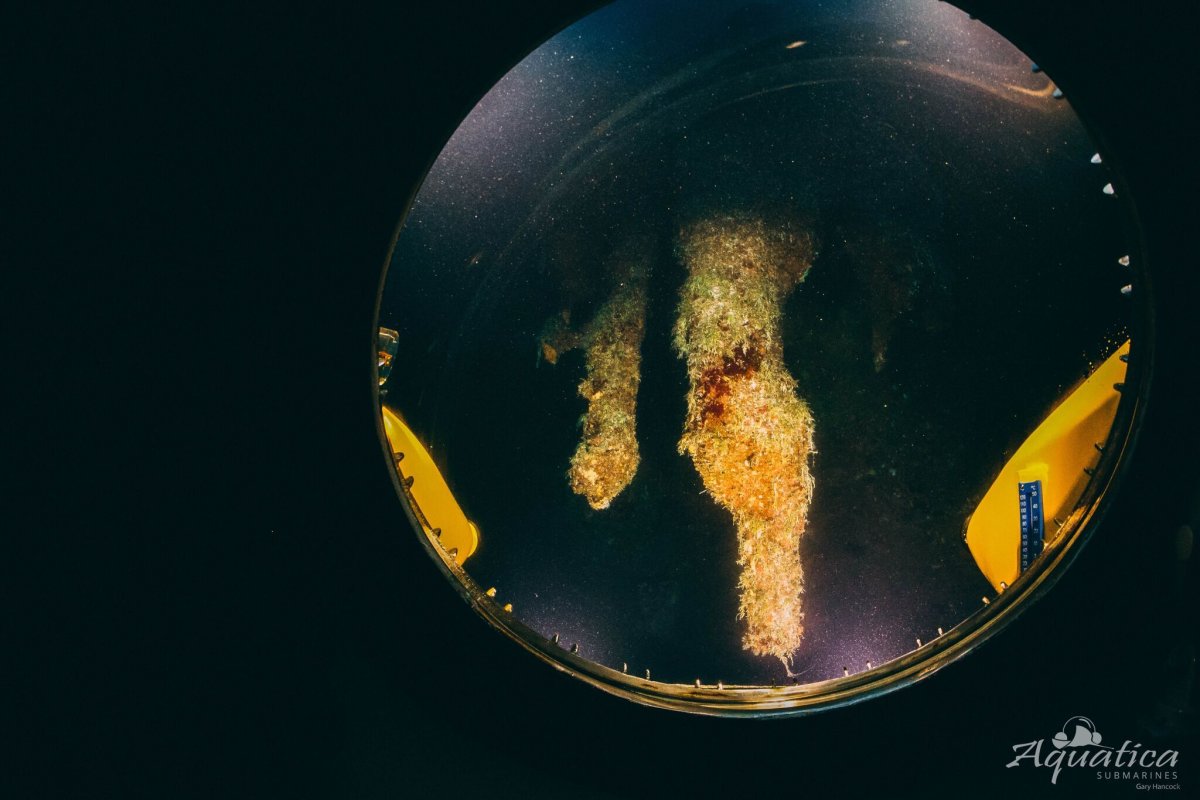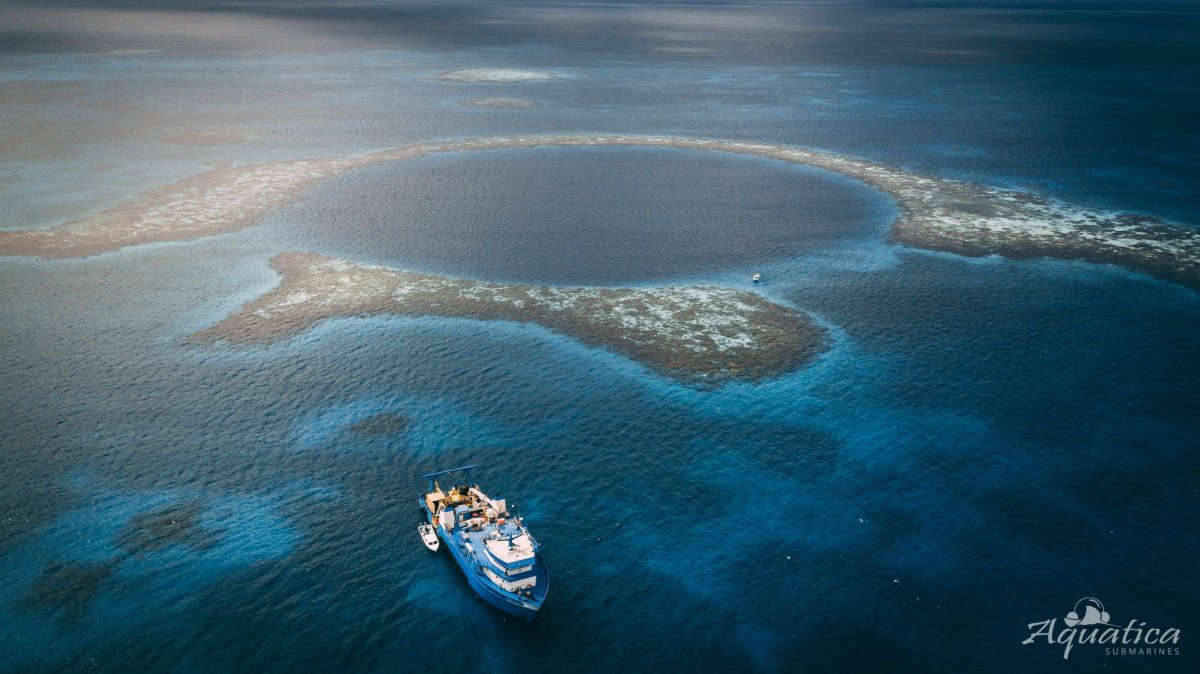The Great Blue Hole off the coast of Belize is the world's biggest ocean sinkhole, measuring 1,000 feet across and over 400 feet in depth. It formed thousands of years ago as a limestone cave. As sea levels rose at the end of the last ice age, it was submerged. In the 1970s, the site was popularized by legendary explorer Jacques Cousteau. Ever since then, it has been a popular diving site—but its internal structure, features, and what lies at the very bottom remained a mystery.
In December last year, an expedition into the Great Blue Hole took place. Billionaire Richard Branson and Fabien Cousteau (the explorer's grandson) joined Erika Bergman, National Geographic Explorer and submersible pilot for Aquatica Submarines, which led the expedition, in a dive to the bottom of the chasm.
Now, researchers working on the project have released the first 3D maps of its interior and a minidocumentary about their findings. In the film, released by Aquatica Submarines, Bergman and Mark Atherton, the expedition's sonar expert, discuss their findings—and how the dive has shed new light on the ancient formation. This included what it was like dropping through the hydrogen sulfate layer—beneath which there is no oxygen.
In an interview with Newsweek, Bergman said the hydrogen sulfide (H2S)—what we normally think of as a colorless, flammable, corrosive and toxic gas—is dissolved in water. While less concentrated than in its gas form, it is still potent, and sea life in the Blue Hole will not pass through the layer. During the dive, the team discovered the H2S layer sits at a depth of 290 feet and blankets the entire hole.
"Anything that fell into the hole decomposed until that process used up all of the oxygen below 290 feet," she said. "That means that below the H2S, there's no oxygen and anything that falls down there now is preserved.
"Without oxygen, nothing survives. Beneath the hydrogen sulfide layer it is very dark. Looking straight up from inside the submarine you can just barely make out the circular opening of the hole, all of the light pouring into the hole is shut out by the thick chemical layer."

Explaining what they saw beneath the H2S layer, she said they found hundreds of conchs and marks where divers had tried to escape, old scientific equipment and a GoPro—footage still in tact. But they also found the bodies of two divers who had been lost in the hole. How many people have died in the Great Blue Hole is not known, but in a previous interview with Business Insider, Bergman said there are thought to have been three people go missing in it.
"There were...these odd tracks, crisscrossing circles right around the center of the hole with no indication of what had made them," she told Newsweek. "Mostly it was quiet and dark down there. We also encountered the resting place for two of the divers who've been lost in the hole. We notified the local authorities, and everyone agreed to leave them undisturbed. They are at peace."

The team also recorded some interesting features that provides an insight into how the cave—and the surrounding land—has changed over thousands of years. They recorded huge stalactites that had shifted position, showing how the tectonic plates had moved the land.
"The stalactites are enormous, some are more than 40 feet long and two feet in diameter. They form due to the slow drip of water and crystallization of minerals as the water drops dry on the tip of the mineral stone," Bergman said. "Water won't drip underwater—so this was a dry cave when the sea level was much lower. The drips are subject to gravity, so the stalactites can only form exactly vertically from the cave roof. So why are these stalactites tilted up to 12 degrees? The power of moving tectonic plates must have shifted between the stalactites off vertical within the last 200,000 thousand years since the oldest stalactites in the hole began to form.

"Can you imagine entire continents being tilted sideways by the smash and slip of the plates we live on? That's what's happening. And that's why the tilted stalactites are so cool."
Bergman also said that there was an enormous cavern near the bottom of the hole. She said there is evidence that this could be part of a larger underwater cave system. "The roof has collapsed on this particular cave, but the whole reef could be dotted with similar caverns which simply haven't collapsed into blue holes...yet," she said.
There are no plans to return to the Great Blue Hole with the submarines at present, but Bergman said other scientific teams may want to go back and examine more of the Blue Hole's features. The team is now analyzing the data gathered and looking for comparisons with other marine sinkholes. "Primarily, we've identified terraces in the Great Blue Hole that match up with terraces in other oceanic blue holes," she said. "These terraces are indications of sea levels in centuries passed. What we're finding is that sea level rises in steps, often big steps. So looking forward we can expect sea levels to follow similar patterns. And I'll tell you what, sea level rise is not gradual. So get those waders out."
This article has been updated to include more information about people lost in the Great Blue Hole and information about Aquatica Submarines leading of the project.

Uncommon Knowledge
Newsweek is committed to challenging conventional wisdom and finding connections in the search for common ground.
Newsweek is committed to challenging conventional wisdom and finding connections in the search for common ground.
About the writer
Hannah Osborne is Nesweek's Science Editor, based in London, UK. Hannah joined Newsweek in 2017 from IBTimes UK. She is ... Read more
To read how Newsweek uses AI as a newsroom tool, Click here.








